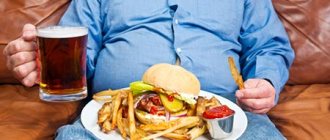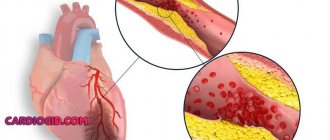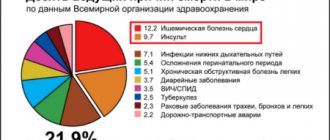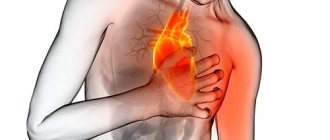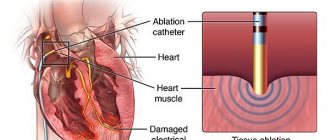Definition
Functional classes of angina pectoris are the division of the disease depending on the patient’s tolerance to physical activity.
Functional classes (FC) of angina are distinguished according to the classification proposed by the Canadian Heart Association. Angina pectoris occurs as a result of insufficient blood supply to the heart muscle during work. When performing physical exercises, stress and anxiety, the heart's need for oxygen increases, which is why attacks with angina pectoris are associated with any kind of stress. There are four functional classes of angina: I-III refer to stable angina, IV - to unstable form. The higher the class, the less the patient is able to freely perform physical activity.
Spinal cord and spine injury
The technology of the rehabilitation process at the stage of medical rehabilitation begins and ends with an expert assessment of the effectiveness of rehabilitation.
At the end of the 20th century T.A. Stasevich and V.B. Functional classes were proposed to assess the rehabilitation process.
Functional class (FC)
was proposed for a comprehensive assessment of the state of function of a particular body system and assumed a 5-point scale, subject to taking five points for 100% intact function.
FC-0 characterizes the initial state of the parameter, FC-1 is a slight violation (up to 25%), FC-2 is moderate (from 26 to 50%), FC-3 is significant (from 51 to 75%), FC-4 - pronounced or complete violation of this parameter (from 76 to 100%) [11].
FC assessment was proposed for each studied rehabilitation criterion before and after rehabilitation and expressing the result in the form of a fraction (in the numerator - before, in the denominator - after rehabilitation) in order to highlight the achieved level of rehabilitation (FC after rehabilitation) and the effectiveness of rehabilitation in points based on the difference in FC values before and after rehabilitation. The authors propose the following interpretation of the data [11]:
FK-0 - complete restoration of functions to normal limits. An improvement is assessed when the FC decreases by 1 point as moderate, and by 2 or more points as significant. If FC remains unchanged, but the parameter improves, the effect is assessed as a slight improvement. An increase in FC characterizes deterioration.
Characteristics of the state of functions according to FC (according to T.A. Stasevich)
At the first stage
The degree of functional impairment is determined by FC.
In this case, 2 criteria are used - the degree of dysfunction and the possibility of compensating it
with the help of medical and technical means. If compensation improves the state of a function, its FC is assessed taking into account the effect of compensation.
FC-0
- no dysfunction.
FC-1
— there are mild dysfunctions (no more than 25%), as well as more pronounced impairments, which with the help of medical and technical means are compensated completely or to the extent of mild impairments.
FC-2
- moderate impairment of functions (from 25 to 50%), not compensated with the help of auxiliary aids or a more pronounced impairment, partially compensated to a moderate degree.
FC-3
- significant dysfunction (from 51 to 75%), uncompensated or poorly compensated.
FC-4
- pronounced and complete (over 75%) dysfunction, uncompensated.
At the second stage
The influence of the degree of dysfunction on the state of vital activity is assessed.
Disorders of vital activity can also be compensated with the help of medical and technical means - assistive devices, functional orthoses, the use of additional devices that enhance spatial orientation (sound signals for visual impairment, visual signals for hearing impairment, etc.), communication (alphabet blind, deaf), various mechanisms and machines.
Compensation for disability is the most important goal of rehabilitation
, which is assessed as the effectiveness of rehabilitation. However, when determining disability, if compensation for “ability” does not simultaneously improve function, the disability group is established without taking into account the effect of rehabilitation (a patient with paralysis of both legs is recognized as a disabled person of the first group, even if he is provided with a wheelchair and a car that improve his mobility).
The FCs of the defect and disability do not always coincide. A slight impairment of function can lead to a significant limitation of life activity and, conversely, a significant decrease in function has little limitation of life activity
.
Characteristics and assessment of vital signs
Each of the life activity criteria can be violated in isolation or accompanied by other restrictions that affect the level of social adaptation. Life activity criteria are assessed on the following points: movement, self-care, orientation, communication, learning, ability to work.
Movement
Locomotion - the ability to move effectively in one's environment, providing mobility to a person
. The ability to move can be enhanced and compensated through the use of vehicles, prostheses and other assistive devices to facilitate movement.
Medical and technical means of movement compensation are divided into basic and auxiliary.
The main ones include wheelchairs, bicycles, motorized strollers and cars.
. They improve mobility, increase the quality of life, but do not change the impaired function of the lower extremities and are not a basis for reducing the disability group.
Aids include walkers, prostheses, orthoses, canes, crutches
, facilitating movement; These also include prostheses and orthoses of the lower extremities, which simultaneously improve and partially replace the lost function of the limb. In such cases, the presence or absence of compensation affects the determination of the FC and the expert decision.
The ability to move is determined by the state and integrated activity of many organs and systems: musculoskeletal, nervous, cardiorespiratory systems, sensory organs, etc.
To assess movement
The following parameters are used:
- the distance the patient can move (starting point - bed);
— pace of movement and character of gait (normal, altered);
— the possibility of using medical and technical means to compensate for mobility impairments;
- the need for outside assistance when moving;
— possibility of using transport (public and personal). FC-0 - full mobility.
FC-1 - mild mobility impairment
- maintaining the ability to move long (unlimited) distances with a slight slowdown in the walking pace, a slight change in the walking pattern, the need to use simple aids (cane, simple orthopedic shoes) or medications that completely correct movement disorders (peripheral vasodilators, coronary agents, non-steroidal anti-inflammatory drugs and other analgesics, correctors of muscle tone disorders, hyperkinesis, etc.). The use of transport is not limited.
FC-2 - moderate mobility impairment
(reduced mobility) - limitation of the distance of movement by the area of residence (up to 1.5-2 km), slow pace of walking, obvious changes in gait, the need to use more complex aids (functional types of prostheses, orthoses), incomplete drug correction of impaired functions; using transport is difficult, but possible without assistance.
FC-3 - significant limitation of mobility
- movement only within the immediate neighborhood (up to 0.5 km), a sharp change in gait and walking pace, the need to use complex mobility aids (crutches, walkers, prostheses of two lower extremities or one with significant impairment of the function of the other, atypical, complex prosthetics for low-functioning types of prostheses, orthoses, etc.) or wheelchairs. It is impossible to use public transport without the assistance of others; using personal transport is difficult and not always possible.
FC-4 - complete loss of mobility
and severe restriction of movement - restriction of mobility within the boundaries of a home, chair or bed; walking around the room with special arrangement of housing with handrails or with the help of low-functional, mainly fixing, orthoses, prostheses with the obligatory additional use of crutches, when only the push-pull nature of the biomechanics of walking is possible (“kangaroo step”), mobility outside of housing only when using basic means of transportation ( stroller, etc.) or with outside help (guide for the blind).
Self-service
Self-service
- the ability to take care of oneself, cope independently with basic needs, and ensure effective independent existence in the environment without the help of others.
Self-care includes independent satisfaction of the most important daily regulated needs (physiological functions, personal hygiene, dressing and eating) and the implementation of a wider range of everyday household needs (shopping at the store, cooking, cleaning the room, making the bed, laundry (small and large), maintaining proper room temperature, using locks, switches, taps, various household appliances, telephones, etc.), for which assistance from outsiders can be planned and provided less than once a day or occasionally.
To realize the ability for self-care and physical independence, the integrated activity of almost all organs and systems and the preservation of the main aspects of life are required. Initially, self-care is limited when the ability to use hands, control the body, move and behave adequately is impaired. Self-care may be partially compensated for by assistive devices.
Parameters for assessing impairment of self-care and physical independence
serve:
— need for outside help and care
when meeting regulated or unregulated needs;
— intervals at which such need arises
: episodic need (1-2 times a week), long intervals (24 hours or less), short (every few hours), critical (shorter and unpredictable) intervals and constant need;
— possibility of correction with the help of auxiliary means and adaptation of the room
.
FC-0 - complete independence
- the ability to effectively exist without outside help and aids.
FC-1 - mild physical dependence
- the need for small, intermittent and unregulated help from other persons (general cleaning, major laundry, minor repairs, etc.) or full compensation with the help of small technical means and devices (dentures, devices regulating excretory functions, preventing uterine prolapse and etc.).
FC-2 - moderate physical dependence
- the need for occasional assistance from other persons in the implementation of one or more regulated needs in the independent organization of everyday abilities (assistance in getting in and out of the bath, in seasonal food preparation, in the use of individual household appliances, etc.) or the use of technical means and devices, significantly compensating for impaired function and ability (prostheses of one lower limb, regulation of excretory functions by adaptive devices or stimulators) or adaptation of housing.
FC-3 - significant limitation of physical independence
- the need for systematic assistance from other persons at long intervals (once a day or less) in satisfying several or many regulated needs (buying groceries, washing in the bathroom, cleaning, heating, using certain household appliances, etc.) or partial compensation of physical dependence with with the help of technical means and devices (prostheses of both lower extremities, orthoses, splints, walkers, strollers), provided that the patient uses them independently or only occasional assistance in certain actions (removing a motorized stroller from the garage, subject to the patient’s independent exit from the home and moving into and out of the wheelchair strollers).
FC-4 - pronounced and complete impairment of physical independence
- includes a violation of self-care in the narrow sense of the term - the need for help from outsiders in meeting unregulated needs at short and critical intervals, or constant and partial compensation with the help of technical means and devices, if the patient cannot use them without outside help (inability to put on a prosthesis independently or orthosis, inability to move independently into a wheelchair).
Unregulated needs, in addition to physiological functions, personal hygiene, dressing and eating, include the inability to move without assistance within the home.
FC-4 is determined not only by a violation of all of the listed abilities, but also by any of them, for example, movement around the room or uncontrolled disturbances of physiological functions.
Orientation
Orientation
- the ability of a person to independently navigate the environment, perceive and analyze its state and respond accordingly to its changes.
To realize orientation, the integrated functioning of several systems is necessary: sensory organs, central nervous system, musculoskeletal system.
Orientation disorders
at the level of analyzers can sometimes be fully or partially compensated by medical and technical means (glasses, lenses, hearing aids, electrical devices, etc.) or by compensation of one analyzer by another (a deaf person compensates for his deficiency with vision, a blind person with hearing and touch, and etc.). Compensation for mental disorders can be achieved with medications (neuroleptics, etc.).
To characterize the severity of orientation disorders, the following are used:
- assessment of the state of orientation systems and the possibility of their compensation; - assessment of the state of communication systems and the possibility of their compensation;
- degree of orientation in one’s own personality, place, time and space;
— ability to analyze and adequately respond to received information;
- the possibility of compensating speech and behavior with medications and other means.
FC-0 - normal ability to perceive, analyze and react
on information, providing the ability to independently navigate the environment.
FK-1 - slight orientation restriction
- occurs with severe unilateral or mild bilateral dysfunction of one of the orientation systems (vision, hearing) or with a more significant impairment, but the possibility of good compensation of functions with the help of technical means (glasses, hearing aids) or with mild mental disorders that are almost completely compensated due to the systematic use of medications; with episodic disorientation due to various but rare paroxysmal conditions (epileptic seizures, dizziness, etc.), temporarily disrupting orientation.
FC-2 - moderate disorientation
- is determined by a significant disruption of the activity of one of the orientation systems, which is not compensated or is not compensated insufficiently (bilateral decrease in vision to 0.11-0.15, WHO grade III-IV hearing loss in both ears), a tendency to frequent paroxysmal orientation disturbances, which not compensated for by medications, mild disorientation only in place or time while maintaining orientation in other parameters, reduced and delayed reaction to information about the environment.
FC-3 - significant disorientation
- determined by a significant impairment of visual orientation (poor vision in both eyes - 0.06-0.1 or hemianopsia), with simultaneous moderate damage to two orientation systems (vision and hearing), which impair orientation capabilities, with partial disorientation in place, time, space and one’s own personality, with severe sensory aphasia, if the listed disorders are not compensated by medical and technical means, but do not require the need for constant outside help and care.
FC-4 - pronounced disturbance of orientation
, which occurs with a complete and pronounced violation of the visual orientation system (blindness or decreased vision in both eyes to 0.05 with correction, “tubular” vision - field of view no more than 10), significant damage to two systems of the orientation system, including vision (low vision and bilateral deafness) or orientation and communication systems (bilateral deafness and significantly pronounced motor aphasia), as well as severe disorientation due to mental illness or sensory aphasia, if these disorders cannot be compensated.
Communication
Communication
- a person’s ability to establish contacts with other people and maintain familiar social relationships. Communication is communication, the need to generate, distribute, perceive and understand messages through means of communication.
The main means of communication is speech, the auxiliary means are reading and writing. Communication can be carried out using both verbal (verbal) and non-verbal symbols. In addition to the preservation of speech, communication requires the preservation of orientation systems (hearing and vision). Another condition for communication is the normal state of mental activity and psychological characteristics of the individual. Communication is communication in the physiological sense, which shows the incomplete content of this term.
Social integration
- a complex multifaceted process of establishing and developing all forms of contacts between people, based on the need for joint activities. The main social content of this concept is the manifestation of human social existence. Communication is a means of transmitting forms of culture and experience, training, organizing production, scientific and other types of activities, forming the mental and emotional-volitional sphere of a person. It is in this broad understanding that communication characterizes the ability to integrate into society, and its violation leads to social failure or maladjustment.
Social integration requires the coordinated activity of many organs and systems and the preservation of other, more basic human abilities (self-care, mobility). Most of the violations of social integration are formed in many diseases, when communication disorders are secondary (bedridden and limited communication and movement within the home). The primary limitation of communication occurs when the communication systems, orientation are damaged, mental activity is impaired and the presence of psychological characteristics of the individual.
The parameters for characterizing communication are assessing the possibilities of contacts with an expanding circle of people
: with immediate family, friends, neighbors, colleagues, with new people.
FK-0 - normal communication
(socially integrated persons) - the ability to participate in all normal social relationships.
FC-1 - slight restriction of communication
- restrained contacts (due to the psychological characteristics of the individual) while maintaining the fundamental possibility of communication at different levels, or a violation of only one of the forms of communication at different levels, or a violation of only one of the forms of communication while maintaining all others (impossibility of marriage due to sexual disorders and etc.); mild speech impairment (stuttering, mild motor or amnestic aphasia, moderate audiogenic dysplasia with bilateral hearing impairment, moderate dysarthria without other disorders, etc.).
FC-2 - moderate communication disorder
- inability to establish and maintain new contacts while maintaining established contacts - reduced communication: with mild mental disorders, severe psychological disorders (with pronounced accentuations of character, psychopathization of personality, pathological lack of communication, excessive shyness, etc.), with moderate speech disorders (mild sensory or moderate motor and amnestic aphasia, severe audiogenic dyslalia - speech and hearing defect due to bilateral hearing impairment since childhood), with severe bilateral hearing impairment (WHO grade III-IV hearing loss, chronic bilateral deafness).
FC-3 - significant communication impairment
- disruption of established contacts (friends, neighbors, colleagues) while maintaining relationships with significant people (close relatives) - impoverished communication: severe mental disorders, complete motor, severe sensory aphasia, the impossibility of non-verbal communication in deaf-mute people since childhood due to illiteracy or lack of training, including lack of training in acute bilateral deafness.
FC-4 - pronounced impairment and inability to communicate
- difficulties in maintaining contacts even with close relatives or the inability to maintain relationships with other people with significant and pronounced mental disorders and sensory aphasia.
Learning ability
Learning ability
— the ability to perceive, assimilate and accumulate transferred knowledge, to form experience, skills and abilities is one of the most important integrative forms of life. Depends on the state of mental functions (intelligence, memory, attention, level of consciousness, thinking, etc.), the preservation of communication systems (verbal and written) and orientation (vision and hearing, etc.). At the same time, learning requires the use of the ability to communicate, move, self-care and other factors (psychological characteristics of the individual, the state of the locomotor system, visceral functions, etc.).
Parameters
To
assess learning ability the
following are used:
— training opportunity (training at an educational institution or at home);
— volume of training;
— terms of training;
— the need to use special teaching aids.
FC-0 - normal training
— obtaining education in a manner and within the framework usual for a child (taking into account age, place of residence, and other factors).
FC-1 - mild learning disability
- the possibility of studying in a regular educational institution in the presence of difficulties, with the need for temporary exemption from certain subjects (according to the conclusion of the Higher Quality Committee), periodic non-attendance at classes due to exacerbations or the need for course treatment, as well as the need for occasional assistance in certain types of activities or the use of minor technical funds.
FC-2 - moderate learning disability
- training with the regular use of serious technical means, training in a special school or special class with a regular training period or a slight extension of 1 year (schools for children with hearing and vision impairments).
FC-3 - significant impairment of learning ability
- the possibility of training only in special boarding schools using special techniques, methods and means of teaching and a significant extension of the duration of training (schools for the deaf, blind), reduction of the program (auxiliary special schools for mentally retarded children), as well as training at home (without taking into account the volume programs).
FC-4 - inability to learn
.
Ability to work (work capacity)
FC-0 - ability to work is completely preserved.
FC-1 - minor disability.
FC-2 - significant disability.
FC-3 - the ability to work only in specially created conditions.
FC-4 - impossibility of work.
In order to use a unified approach to assessing the rehabilitation process based on WHO recommendations (MKF scale), as well as taking into account previous experience, we proposed a unified assessment of the structure and function of the patient’s body and a scale for integral assessment of the effectiveness of rehabilitation treatment (Tables 6 and 7).
Verification of functional status is quite a complex task. Existing assessment systems, as a rule, are too subjective or, conversely, overloaded with objective research. The selection of assessed signs does not provide a sufficiently complete description of the functional state of the spine, the function of the upper limb, and the supporting and locomotor functions of the lower limb. At best, an integral characteristic of the state of the limb is given without identifying the causes of this functional state. This, in turn, makes it difficult to draw up an adequate program aimed at restoring the function lost as a result of injury.
To eliminate the shortcomings of the integral assessment of the functional state, it is necessary to use the developed system of comprehensive assessment of the functional state in case of traumatic injuries and their consequences
.
Ivanova G.E., Tsykunov M.B., Dutikova E.M. Organization of the rehabilitation process // Rehabilitation of patients with traumatic disease of the spinal cord / Under the general direction. ed. G.E. Ivanova, V.V. Krylova, M.B. Tsykunova, B.A. Polyaeva. - M.:, 2010. P. 194.
Angina pectoris 1 FC
With 1 FC of exertional angina, the patient copes well with normal daily activity. Activities such as vigorous walking and climbing stairs do not cause an angina attack in the patient. It is quite rare for people with this functional class to go to the hospital, since the person may not even know about the presence of the disease. As a rule, symptoms of angina pectoris appear when performing fairly intense exercises, very fast and long runs, and loads that are unusual for an ordinary person. To diagnose angina pectoris FC1, it is necessary to use the bicycle ergometer test method.
Causes of angina pectoris
One of the main reasons for the development of angina pectoris is atherosclerosis. There are a number of risk factors under the influence of which the disease not only begins, but also progresses.
Unavoidable factors for exertional angina are genetic predisposition, the person’s gender and age. Until approximately 50-55 years of age, men are more susceptible to angina pectoris. After menopause in women, that is, after 50 years, the percentage of patients of different sexes equalizes.
Avoidable risk factors:
- Smoking.
- Physical inactivity.
- Diabetes. The disease cannot be completely defeated, but following the doctor’s recommendations reduces its severity and, accordingly, reduces the likelihood of changes in the blood vessels.
- Arterial hypertension. Just like with diabetes, controlling the course of the disease reduces the risk of complications.
- Obesity.
- Psycho-emotional stress.
- High cholesterol levels.
Angina pectoris 2 FC
Angina pectoris FC 2 suggests minor restrictions on physical activity. An attack may occur when:
- walking more than 200 m;
- quickly climbing stairs;
- strong emotional overexcitation;
- walking against the wind;
- smoking;
- overeating.
If the patient avoids these factors, angina may not manifest itself for quite a long time. The pain usually stops soon after taking nitroglycerin or at rest. However, over time, symptoms may begin to appear with less significant stress. In this case, angina is often a symptom of coronary heart disease.
Stable angina pectoris FC 2 requires some restrictions in the patient’s physical activity, as well as drug treatment. Usually the patient is prescribed drugs that stop the attack, normalize blood pressure and improve blood quality. Prevention is no less important, in particular, quitting smoking, healthy eating, and physical activity within the limits allowed by the doctor.
Treatment of angina pectoris
The patient's treatment plan is drawn up individually. First of all, standard therapy for coronary artery disease is prescribed using beta-blockers, antiplatelet agents, and drugs that reduce blood cholesterol.
During an attack, nitroglycerin helps relieve pain. For frequent episodes of exacerbation, prolonged (long-term) action nitrates are prescribed - Isosorbide mononitrate, Isosorbide dinitrate, nitroglycerin ointment or patch.
Complex therapy includes the elimination of all risk factors for the disease, diet therapy, and the choice of optimal physical activity.
Angina pectoris 3 FC
Angina pectoris FC 3, in contrast to functional classes 1 and 2, involves significant restrictions on physical activity, since at this stage an attack can occur when moving at a normal pace or when climbing stairs just one flight. Sometimes an attack can be triggered by hypothermia or excessive eating or smoking. Very rarely in this functional class is angina at rest, which occurs during a supine position or severe anxiety.
In this case, treatment of angina pectoris is carried out as part of the treatment of coronary artery disease. It includes taking medications that lower cholesterol and thin the blood. In addition, the patient is prescribed medications that relieve pain and normalize blood pressure. However, if angina pectoris type 3 becomes unstable, pain syndromes become more frequent and last longer, then a decision is made about surgical intervention.
Angina pectoris 4 FC
4 FC of angina is the most difficult, because a painful attack in this case often occurs without obvious reasons (angina at rest). Any minor load can provoke an attack. In this functional class, the patient’s medical history may already include myocardial infarction or cardiovascular failure. Against the background of a recent heart attack, attacks are especially dangerous - with early post-infarction angina, they occur spontaneously and can lead to a second heart attack.
If a person has difficulty walking, shortness of breath, or pain in the sternum that does not go away within 15 minutes, it is necessary to urgently call the Ambulance Service, because in this case we may be talking about acute coronary syndrome and the patient requires treatment and observation in a hospital.
When should you see a doctor?
The severity, duration and form of angina may vary. It is important to determine whether your chest pain is changing or developing new sensations. A signal of a more dangerous form of unstable angina or a heart attack (myocardial infarction) may be the appearance of new symptoms or a change in existing ones.
If you notice that angina attacks have begun to recur more often, their nature and intensity have changed - this is a reason to think about a cardiac examination as soon as possible. You can make an appointment with a specialist at our clinic or get answers to your questions using a service such as online consultation with a cardiologist - it is available on our website at any time.


